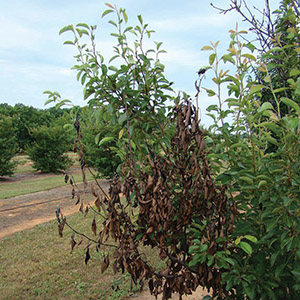

Apple flowers develop in a mixed bud containing both vegetative and reproductive tissues. Although no fire blight was observed in the 2007 trial, we observed the rotating nylon strings of the mechanical blossom thinner not only removed apple flowers, but also shredded primary spur leaves, leaving many fresh wounds. Used at pink, the thinner effectively reduced fruit set, decreased time required for follow-up hand thinning, and increased fruit size of ‘GoldRush’/M.26 apple trees.
#Fire blight on apple trees trial#
Several extensive trials were conducted in commercial peach orchards, but as a result of concerns about fire blight, only one preliminary trial was conducted on apple at the Penn State Fruit Research and Extension Center. In 2007, Penn State researchers tested a mechanical string thinner for blossom thinning of fruit trees ( Schupp et al., 2008). Interest in economical nonchemical thinner alternatives for use in the tree fruit industry is increasing as the supply of farm workers continues to decline and labor costs increase. Keywords: crop load management risk assessment blossom thinning Malus domestica amylovora otherwise, a severe fire blight epidemic could develop in the orchard. The use of the thinner should therefore be limited to orchards with no history of disease in the last 3 years and on days when predicted weather is not suitable for tree infection by E. These results indicate that under conditions conducive to infection, the mechanical blossom thinner significantly increases the risk of spreading Erwinia amylovora. A similar result was obtained in greenhouse experiments whereby healthy apple plants positioned adjacent to diseased plants before the group was subjected to the mechanical thinner developed more than twice the number of infected shoots as that on similar plants that were not thinned. In the field experiment, using the mechanical thinner on noninoculated trees immediately after operating the equipment on inoculated trees significantly ( P < 0.01) increased fire blight incidence resulting in 90 ± 20.01 (mean ± SE) infected shoots compared with 23.5 ± 8.97 diseased shoots in similar trees that were not thinned mechanically. Several consecutive days of ambient temperatures near 33☌ in 1994 raised temperatures inside the tents to 56☌, resulting in complete eradication of the pathogen and death of tops of the trees.The risk of spreading fire blight in apples after mechanical thinning with a rotating string blossom thinner was evaluated in field and potted-tree experiments.

amylovora were isolated from cankers, while cankers on untreated trees continued to expand. In many solarized trees, canker expansion was stopped and no viable E. Results were variable depending on tree species, ambient temperatures, and the year. Temperatures at 3 heights inside the tent, and ambient temperatures were recorded. High temperatures and reduced water and nutrient availability are reported to stop disease progress but growers are usually unable to control these factors.Įlevated temperatures obtained through solarization of soil have been shown to reduce inoculum of pathogens.Īpple and pear trees with active cankers were completely covered with a 10 x 10 m polyethylene tarp left in place for 4 to 7 days in the summers of 19. Solarization of entire trees under "tents" of clear polyethylene was used as a means to stop the progress of fire blight infections and eradicate Erwinia amylovora from infected tissues. ISHS Acta Horticulturae 411: VII International Workshop on Fire Blight SOLARIZATION OF PEAR AND APPLE TREES TO ERADICATE BACTERIA IN FIRE BLIGHT CANKERS SOLARIZATION OF PEAR AND APPLE TREES TO ERADICATE BACTERIA IN FIRE BLIGHT CANKERS


 0 kommentar(er)
0 kommentar(er)
